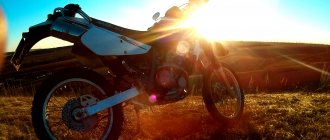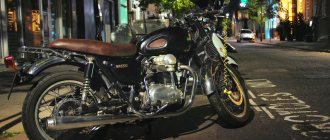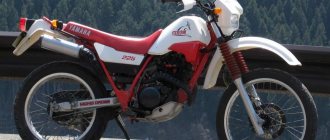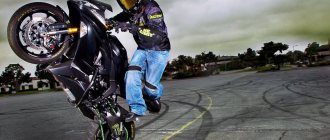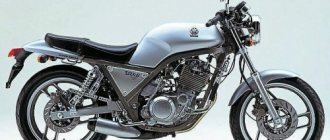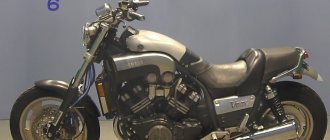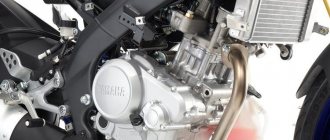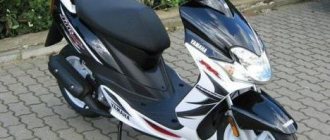The main goal of a first-season motorcyclist is to survive. Neither a powerful chopper, nor fast sports, nor driving skills in the Urals in your grandfather’s village will help you master driving techniques in a metropolis. Learn to change lanes in traffic, fit between rows, maneuver freely and calculate the road situation - for this, a beginner does not need a fast car or a chrome-plated beauty. The purpose of the first motorcycle is to teach and give joy. The joy of owning an iron horse, the headwind in your face and the endless horizon of roads that open up for you.
No one knows for sure how many thousands of newcomers the Yamaha YBR 125 has “trained” and successfully released into the motorcycle world over the course of more than ten years. Affordable price, ease of operation, ideal weight and dimensions make the Ebrik the undisputed market leader among educational and small-capacity motorcycles.
Advantages and disadvantages of Yamaha YBR 125
What allows a Chinese-assembled dairy road builder to remain stable on the Russian market for more than a decade?
The Yamaha YBR125 motorcycle has been produced from 2004 to the present, and is deservedly positioned as an inexpensive motorcycle for study, or as a light road bike for beginners. Let's take a look at the insides of the ebrik:
- Engine capacity – 125 cc;
- Number of cylinders – 1;
- Four-stroke engine;
- The gearbox is 5-speed;
- Drive system – chain;
- Length – 1980;
- The front tire size of Yamaha YBR125 motorcycles is 2.75-18 42P, and the rear tire size is 90/90-18 M/C 57P;
- It weighs 122-125 kg. depends on the model;
- Minimal body kit.
Everything is kept as compact as possible for its class: electronic and kick starter, air-cooled engine with a capacity of 10 horsepower. It will not look for surprises in the design and chassis - a diagonal frame made of steel, a telescopic front fork, with double shock absorber. The brakes are classic: front disc, hydraulic, and rear drum.
As a result of 4 generations, the result was an ideal device: reliable in operation, unpretentious in maintenance and repair, economical in consumption, maneuverable and easy to operate. Add the cost, which corresponds to the quality, and you will understand why demand does not fall, and the Yamaha YBR 125 technical specifications that we cited above remain on the assembly line for so many years. The Japanese concern's focus on simplicity has paid off.
It took me three days to write a review about the Yamaha YBR125 model, after three seasons.
What has changed in the Yamaha YZ125 since 2006?
The best thing Yamaha engineers have done to it over the years is install Kayaba SSS suspension in 2006, moving from 30 percent speed-dependent damping to 90 percent. As for the rear suspension, its monoshock was almost custom: 18mm rod (instead of 16mm), Kashima coating on the internal elements, 30% larger reservoir volume and a titanium spring. Unfortunately, since 2006 there have been no more important changes to the Yamaha YZ125.
Here's what's been done with it since then:
- 2007: The forks were made slightly tapered in the middle and a new damping valve was added. The steel components of the Kayaba shock absorber have been replaced with lighter aluminum ones. A large Protaper Contour steering wheel replaced the old steel steering wheel. In many components of the motorcycle, steel fasteners were replaced with aluminum. The perforated section of the muffler internals has been shortened by 75mm to improve throttle response without increasing exhaust volume.
- 2008: The YZ125 inherits the front brake, fork stays, fork bottom bracket and chain guard from the YZ250F. A new reed valve was added and the front brake master cylinder was reduced by 1.48 mm.
- 2009: Yamaha replaced the large steel brake hose holder with a lightweight aluminum one. The 2009 YZ125 also gets new seat trim and new Dunlop 742F front tires.
- 2010: New graphics
- 2011: Yamaha has stopped producing different versions of motorcycles for different markets. They switched to a single model with characteristics common to all markets. The main changes made to the global version were aimed at the ability to run on lower octane gasoline. For example, remember that in 2007 Yamaha shortened the muffler internals? So, in the 2011 version, they returned the length to where it was and increased the channel cross-section from 27 to 30 mm. In addition, the 410 main jet was replaced with a 430, and the 6BFY42-3 needle was replaced with a 6BFY43-3.
- 2012-2014. In addition to the entertainment of replacing the blue wing with a white one, and the white with a blue one, the versions of these three years differed only in new, extremely high-quality graphics.
- 2015: Unification of plastic design with four-stroke models, improved fork damping and a new air filter housing.
- 2016: gold chain, black rims and new, mind-blowing graphics.
- 2017: The front brake disc was increased from 250 to 270 mm, and the brake pad friction material was improved.
- 2018: The black rims were replaced with blue ones. Well, yes, graphics. New.
Yamaha YBR125 motorcycle. The quieter you go, the further you'll get
YBR125, although produced in China, is controlled by a Japanese concern. Like all “Japanese” cars, it is designed for driving, not for repairs. And the use of our roads could not “kill” the Yamaha during my test drive. I will give the opinions of other users at the end of my story, in the “Yamaha YBR 125 reviews” section.
So, in order. In the fall, the Honda Steed 400 was finally disassembled and sold for parts, but I didn’t want to miss the season at all. Sports and endurikes did not attract me, and the most similar to the classic and cheapest in price was the Yamaha YBR 125, the features of which forced me to consider it in more detail. The semi-fairing and the dashboard with two glasses give the motorcycle the very desired appearance. The seating position turned out to be surprisingly comfortable, and the first hours on the road confirmed that I had made the right choice.
At home, the first thing I had to do was adjust the idle speed. With factory carburetor settings, a Yamaha YBR125, produced in 2006, is only suitable for the first lesson in a driving school. Acceleration at the start is positive, and maneuverability in between rows confirms the title of “Traffic Killer”; even on a scooter there is no such efficiency when passing through traffic jams.
The motorcycle moves through potholes softly and impressively, as if not noticing them on the road, the suspension behaves smoothly, but this is up to 60 km/h. Shock absorbers, in general, work 70% percent. A couple of days later, after the first evening trip, I had to disassemble the fairing and adjust the headlight myself. A little later, I replaced the standard headlight with a lensed one.
When on the highway you want to turn the throttle all the way, you immediately stumble over short gears and the number 100 on the speedometer. Yobrik, as it were, accustoms you to a calm driving regime, hinting that you will never be late for your wake. These are the technical characteristics of the Yamaha YBR125 motorcycle.
Cons of Yamaha YZ125
Engine. The traction has to be adjusted with the clutch, because there is almost none at the top. If you overclock it a little, you won’t be able to accelerate, and this is the main drawback of the Yamaha YZ125.
Front tire. It’s not clear why we continue to put the front wheel on a Dunlop MX52 that’s not really good for anything. Simply replacing it with a Dunlop MX3S or MX33 can significantly improve the performance of the bike. Moreover, in the rear, these tires perform quite well, especially on hard terrain.
How much does he eat? how long does it take?
The first gear holds up to 30 km/h without loss, the gear pitch is small: from 10 to 20 km. To achieve maximum speed you have to work hard. An experienced biker is annoyed by short gears. For the Yamaha Ybr 125, the maximum speed on a straight line is 110, you can’t squeeze more out of it. Although for him it’s fast. Fairy tales about acceleration to 120 km/h are just fairy tales. But the 125 turns into corners no worse than a “sport” and holds the road perfectly.
I’ll say right away that during the season, the equipment was not noticed with excessive oil consumption. In terms of average fuel consumption on the Yamaha YBR125, the reviews are almost the same, with a small dramatic difference. Outside the city I often lack power; I squeeze everything I can out of the engine. But more than 4 liters per hundred, at speeds above 8000, with such aggressive driving, the consumption did not rise. My usual consumption is 2.8 liters per 100 km. I am pleased with the omnivorous nature of the engine - my experiments with fuel from 92 to 98 over the course of the season had no effect on the engine’s performance. The mileage has already exceeded 30 thousand, but the consumption remains the same.
And there will be a hole in the old woman
Yamaha YBR-125 review of identified jambs. Let's start with the tires: the standard “Sakura” on models up to the third version left much to be desired. During emergency braking, both wheels drag. The contact area with the road is very small. Therefore, the tires were changed to Michelin a week later. The ebrik holds the road much more confidently, both asphalt and dirt road. Simply great! By the way, since 2008, the motorcycle began to be equipped with five-spoke wheels and tubeless tubes.
It's better not to fall on the Yamaha YBR125. The first fall cost me three thousand rubles. The plastic shattered into pieces. Too fragile and unreliable, like the included tool. Screwdrivers break on first contact. It’s better to immediately assemble your own reliable kit.
The standard brake, in my opinion, deserves only a solid “3”. Emergency braking is possible, but only with experience, and only if you're lucky. Within a month, I replaced the flimsy original one with a reinforced brake hose.
The gearbox lug must be taken care of and tightened constantly. Otherwise it will get lost. From the second generation of ebricks, the problem was eliminated by changing the location of the paw. I had to tighten it every week until I had it redone over the winter. The box itself works flawlessly, and, in general, there are no particular complaints about the transmission. Only the chain constantly stretches and asks for replacement after 7,000 kilometers. In models since 2008, an oil seal chain appeared, its resource is indicated up to 18,000 km.
Autumn came, the Yamaha YBR125 carburetor began to act up. As the temperature dropped it was difficult to start. The closer it got to the cold, the more problems became. The Japanese solved this problem, and in the third generation, since 2008, the ebrik received a new heated Mikuni VM22 carb, front fork, brake discs, calipers, and pads.
Weak points, of course, were also found in the chassis. The front fork of the motorcycle breaks in places, causing the motorcycle to peck and dangle along the road. On the advice of experienced comrades, I filled the shock absorber with 15W oil and installed two additional valve springs from the VAZ engine. Now, from pit to pit, the shock absorber manages to decompress and adequately accepts the load even with the second number. I will give a table by year of production of 125s, it may be useful.
- 2004 – 2006 - first;
- 2007–2009 – second;
- 2009 – 2010 - third;
- 2010 – to date – fourth.
Yamaha YZ125 2021
First and foremost, is the 2021 Yamaha YZ125 better?
No. The only difference between the 2021 version and 2021 is “high-quality new graphics” (that’s what manufacturers say and do when nothing else has changed in the model). Luckily, for once, the new graphics didn't increase the price, because usually the opposite is true. But there haven't been any major model updates since 2006, and used YZ125 two-strokes sell in large numbers and are easy to maintain, so the 2021 Yamaha YZ125's biggest competitor is not Husqvarna or KTM, but the older Yamaha YZ125s. Instead of going to a dealer, most people go to a classifieds site. And someday there will come a time when Yamaha will have to make a motorcycle from scratch, just to make it at least somewhat different from all those that are sold second-hand.
But is she good?
Yes, of course! Many people, including us, consider it the coolest fun bike on the market. The 125 two-stroke is so light that it can be controlled by thought.
What does it look like on the dyno?
Surprisingly, the Yamaha YZ125 outperforms its European rivals from idle to 8000. In a head-to-head comparison of the KTM and YZ, we found the YZ125 to have better throttle response and more noticeable low-to-mid rev pickup. The YZ125 is also less critical to rider errors; it is more convenient to regulate traction with the clutch when twisting. Unfortunately for Yamaha enthusiasts, after 7,000 rpm the balance of power tilts in the KTM's favor. At 7000 rpm, the YZ125 produces 16.3 hp, and the KTM only 15.37, but then the KTM’s power increases faster than its rival. In a nutshell, the difference between the two is that the YZ125 picks up speed quickly and settles into a smooth run right where the KTM starts to accelerate. The KTM reaches 29.45 horses at 9500 rpm, while the Yamaha YZ125 has 1.5 horses less at the same rpm. Yamaha reaches its maximum power at 11,600 rpm, and this is 35.36 horses, and KTM’s maximum at 11,300 is 38.23 horses. A difference of three horses is a lot for light octagons.
Is it good for young people?
Yes. Most AMA Pros put their kids on a YZ125 before they even let them dream of a 250 four-stroke. The Yamaha YZ125 is great for young riders transitioning from kids' 85s, as well as less experienced riders looking to improve. With a unique 125k power rating, they are a great learning desk for beginners. It's best to learn the importance of timely shifts, torque conservation, late braking and energy management on octobers. And the Yamaha YZ125 is better as a training bike than the KTM 125SX or Husqvarna TC125. How? A clearer response to the throttle and more powerful traction at the bottom. The Austrians require aggressive revving from low to mid to get to traction-effective revs, and for intermediates or pros this is fun, but risky for beginners.
Can the Yamaha YZ125 compete with the new KTM 125SX?
Yes, but not without investment. For full-fledged competition, the blue baby will benefit from the following gifts:
- Exhaust tract with muffler. About 2 horses plus.
- Reed valves. Boyesen Rad Valve or Moto Tassinari VForce4 will flatten the power curve.
- Tuning the cylinder and head. A competent tuner can increase airflow and reduce weight, squeezing out a couple more horses. True, you may need to switch to racing mixtures.
- Stars. Add one tooth back (from 48 to 49) and the ratios of all six gears become friendlier.
How does the Yamaha YZ125 compare to the KTM 125SX?
If you are a Yamaha YZ125 owner, don't even ride the KTM. Why? But because you will have to spend money on changing the bike after you feel the KTM’s top traction. You just won't want to go back to a Yamaha.
Tuning and modifications of Yamaha YBR125
Tuning Yamaha YBR125 is like a drug. The availability of inexpensive spare parts and accessories makes modifications affordable, financially, and very fun. To begin with, I threw out the standard trunk, which had the inscription “no more than 3 kg” on it. My backpack with a tent, sleeping bag and fuel weighs 15 kilograms, and I was not at all happy about losing it on the road. I ordered a new, reinforced tourist trunk with a chrome frame from Ali.
In the nostalgia for the chopper, Steed's fringed leather side cases also found their place. Tuned mirrors of increased size and chrome handles look like original ones. Next season, I plan to change the rear Izhevsk shock absorbers to Honda ones from the SV400. Relatives were taken in the fall, when my friend and I were preparing for our first long-distance trip on the Ebr. The owners' fantasies are amazing. Some people install additional cooling, others use a pendulum on rolling bearings, I’ve also seen YBR-enduro on super “evil” tires.
Pros of Yamaha YZ125
Clutch. When you constantly keep it in the gray zone, you want to hope for its reliability. And it doesn't fail.
Suspension. Whether big or small, new or professional, Kayaba SSS suspension components perform exceptionally well. And they come stock across Yamaha's off-road lineup.
Service. Anyone who has handed over the keys at least once in their life is capable of rebuilding the YZ125 engine.
Armor-piercing. The reliability of the Yamaha YZ125 has become legendary - simply because the components, which have been tested for 13 years in not the most simple tasks, deserve to be called reliable.
Weight. A motorcycle weighing 90 kilograms (almost, see the technical specifications table below) is a very light and nimble motorcycle. On it you can overcome all those obstacles that friends on 250s will force.
Yamaha YBR 125 reviews:
I have chosen several reviews that most fully reveal the opinion of the large army of 125 fans especially for you.
“My motorcycle had a problem with carburetors after winter, I bought a tank flushing additive, filled it in, and after 100-150 km, engine performance improved and the problems disappeared. I go, I don’t complain.” (Alexey, Novosibirsk)
“My friend’s father uses a ebrik for fishing trips. He's been driving without any breakdowns for about two years now, and he likes the handling. I only changed the multi-disc clutch and installed tubeless tires.” (Ivan, Moscow)
“Produced in May 2008, the speedometer showed 1020 km. Consumes little gasoline. The two of us drove 90-100 km/h, the consumption turned out to be 2.7 l/100 km. I'm not happy with the tires, but I won't change them for now. For a 35 W light bulb, the light is quite normal and acceptable. The rear shock absorbers are in the 2nd position, but sometimes they can’t handle the passenger, unfortunately.” (Vladimir, Kiev)
“I recommend purchasing. The overall rating of the motorcycle is 4+. He earns his money honestly. The device is simple and reliable. I'm not going to sell. But I’ll install protective roll bars and update the running boards with sensors.” (Mikhail, Kemerovo)
“I’ve been riding for two seasons after getting my license at a motorcycle school. An ideal bike for learning and suitable for almost any beginner. My friend, Nikolai from Krasnodar, generally rode a ebrik comfortably in Africa.” (Olga, Krasnodar)
“This UBR is an excellent device. With moderate maintenance it will last a long time. Really fast for its class: one cylinder is enough for it. I only had problems with the ignition."
Fourth generation. It's getting steeper and steeper...
Due to strange circumstances, the new model, the 4th generation Yamaha YBR125, is not for sale in Russia. You can only buy a Euro, produced from 2010 to 2021, with mileage, from Japan or Europe. This problem does not stop 125 fans. The price for a 2021 motorcycle without mileage in the Russian Federation is approximately 150,000.00 rubles. Not that much money for a dream.
I was lucky to drive a 2013 125 a couple of times, which my neighbor brought from Japan this spring. Having admired the Yamaha YBR 125 photo enough, studied the innovations on the forums far and wide, I got on the motorcycle with a little excitement.
Of course, it differs from previous models, primarily in its more cheerful design and more ergonomic and durable plastic. On the subject of Yamaha YBR125 technical specifications, number 4, which ignite everyone's curiosity:
- an injector has appeared, making starting easier at any temperature,
- added gear engaged indicator,
- a choke button was placed on the steering wheel,
- added a glove compartment under the seat
- the leading star has undergone changes,
- the brakes and the appearance of the rear turn signals have been improved,
- the front brake became two-piston.
Kind of like a finale
Yamaha engineers meticulously perfect the 125. And, as we know, there is no limit to perfection. If it weren’t for my love for big, chrome-plated monsters, I would, of course, buy the fourth model. I won’t sell my little one, there is a place for it in my garage, and I have time to take it for a “walk”.
As a first bike, the YBR125 is ideal for some people (riders). For regular trips around the city, a temporary replacement or a “second” motorcycle, there is no need to look for the best option. It simply doesn't exist.
If speed is not your main desire when traveling, if you need nimble, economical and easy-to-repair equipment that still looks decent on the road, then this is your option. A sales leader, as the best budget motorcycle, honestly earning every ruble invested in it, loyal to any tuning, the Yamaha YBR 125 of any generation will become your Friend.
Of course, this is just my personal opinion. Take care of yourself, friends, and good luck on the roads!
Video test drive
Specifications
| Maximum engine power: | 10 HP |
| Torque: | 10 Nm |
| Working volume: | 124 cm3 |
| Motor type (cylinder arrangement, number of strokes): | |
| Number of valves: | |
| Intake type (Injector / Carburetor): | |
| Bore and stroke: | |
| Starting system (Electric starter, kick starter): | |
| Maximum speed in km/h: | 120 km/h |
| Cooling system: | Air |
| Transmission (gearbox): | 5 |
| Clutch (Dry / Wet): | |
| Drive unit: | Chain |
| Frame: | Steel diamond-shaped |
| Chassis | |
| Suspension (front/rear travel): | |
| Brakes (Front/Rear): | |
| Wheels / Tires / Rubber: | |
| Dimensions and weight | |
| Dimensions (Length / Width): | |
| Seat height: | |
| Ground clearance: | |
| Curb weight: | |
| Wheelbase: | 1290 mm |
| Weight: | 125 kg |
| Fuel tank capacity: | 13 l. |
| Battery capacity: | |
| Year of release: | |
| Country of Origin: |
Handling Yamaha YZ125
How does the Yamaha YZ125 handle?
Surprisingly good for a bike that will soon be competing in vintage bike racing. In terms of handling, the YZ125 is still a modern model. We tested it on everything from asphalt to deep sand, and the handling in the sand especially surprised us. On dunes big enough to swallow the rider along with it, the YZ125 floats over obstacles with an ease that most 250s only dream of. Moreover, this lightweight device turned out to be so stable in the sand that it self-stabilized even after severe bumps.
Yamaha YZ125
There's an old saying among professional testers: "Slow bikes handle better." And this (unlike other tales of old men) is the pure truth: fast bikes constantly probe the rider, clog his hands and easily move from a smooth ride to “Oh yeah”. It’s easier to make a mistake on fast bikes, or, more accurately, it’s harder to make a mistake on slow bikes. Stable frame geometry and excellent low-end traction make the YZ125 a near-ideal model for those with the most basic skills.



